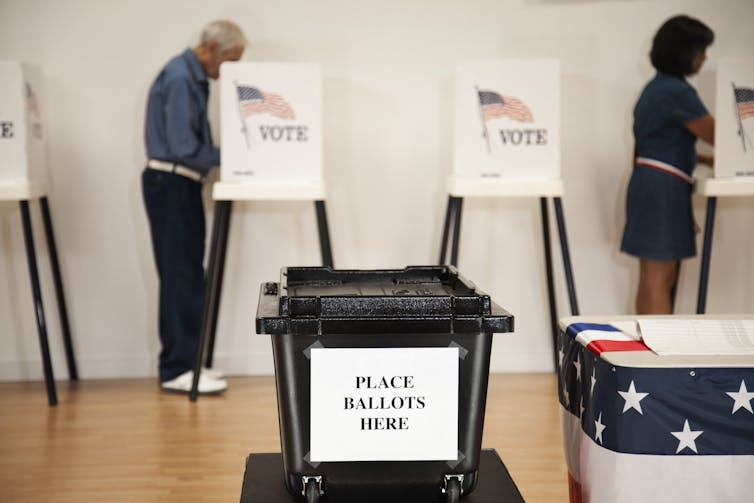
Curious Kids is a series for children of all ages. If you have a question you’d like an expert to answer, send it to curiouskidsus@theconversation.com.
Why does it have to be Democrat vs. Republican in elections? Why can’t it be Republican vs. Republican or Democrat vs. Democrat? – Gianna, age 13, Phoenix, Arizona
Americans are used to having a lot of choices. What to wear today? What to eat? What to read?
Yet in so many elections – when picking a president, state governor or mayor – we seem to have only two choices: Vote for the Democrat or the Republican.
Why does the United States have a two-party political system?
As a political scientist who studies political parties – particularly the Libertarian Party – I can tell you there are other options.
Why do we have a two-party system?
Political scientists like me have a simple explanation for the United States’ two-party system: Duverger’s law, named after French political scientist Maurice Duverger. It states that only two major parties will emerge whenever elections follow a set of rules known as single-winner plurality voting.
Single-winner means only one candidate can win a given election. Plurality voting means whoever gets the most votes wins. Under this system, a party is most likely to win if it runs (or nominates) only one candidate rather than allowing party supporters to split their votes among multiple candidates.
Many voters who prefer an independent or minor-party candidate might decide that it would be more practical to choose among the major-party candidates who have better odds of winning the election. Thus, even when more than two candidates appear on a ballot, voters often believe that they only have two choices: the Republican or Democrat.
Think of it this way: Suppose a teacher threw a class party and agreed to order whatever food the students wanted. There are just two rules: The teacher will order only one food item for the whole class (single-winner), and whichever food gets the most votes wins (plurality vote). Rather than 10 pizza lovers splitting their vote with six for cheese and four for pepperoni – leaving seven ice cream fans to scoop up the victory – they can unite behind one pizza flavor and win.

The same logic explains why the U.S. has a two-party system. When there can be only one winner, and the winner is whoever gets the most votes, people with similar but not identical preferences have good reason to find common ground and work together – or else they’ll lose. They must try to build a coalition of voters that is bigger than any other. In turn, that group’s opponents will try to counter by enlarging their own coalition.
Thus, the rules for voting dictate that we end up with two large “parties” competing to be big enough to win the next election. While other options exist, many voters decide to pick between the only two that can win.
It doesn’t have to be Republican vs. Democrat
While a Democrat or Republican wins most elections in the United States, that doesn’t mean voters can only have two choices. Consider these three points.
First, the U.S. Constitution does not allow for only two political parties. In fact, the Constitution says nothing at all about parties. Many of the Founding Fathers were skeptical of such “factions,” fearing that they would divide the American people and serve the interests of ambitious politicians. Yet many of those same visionaries soon helped to form the first political parties, after realizing the importance of coordinating with like-minded people to win elections and advance a common policy agenda. With a few brief exceptions, the United States has had a two-party system ever since.

Second, plenty of candidates run for office every year as something other than a Republican or Democrat. These include independents who are not affiliated with any party or minor-party nominees – for instance, from the Libertarian or Green Party. It’s just that these candidates typically do not garner many votes and rarely win an election.
Take the nation’s third-largest political party, the Libertarian Party. As my research shows, Libertarians generally agree with the Republican Party on economic issues and the Democratic Party on social issues. This makes the Libertarian Party appealing to some voters who consider themselves fiscally conservative and socially liberal.
Third, in states such as California that have a top-two primary system, elections sometimes come down to two candidates from the same party. This process begins with an open primary in which voters may choose among multiple candidates from various parties at the same time. The top two vote-getters go on to the general election months later – even if they are both Democrats or Republicans.
Other states, such as Maine and Alaska, use ranked-choice voting. This system allows voters to rank all candidates – Democratic, Republican, independent or minor party – from their favorite to least favorite on the same ballot. The winner is whichever candidate gets more than 50% of the vote, either at first or after eliminating the last-place finisher and reallocating that candidate’s voters to their second-choice candidates.
So voters often do have more options than simply Democrat vs. Republican. The problem is that people feel as if only one party or the other has a chance to win – and cast their votes accordingly. It all comes down to the rules for running elections. If you want more choices, you’ll have to change those rules.
Hello, curious kids! Do you have a question you’d like an expert to answer? Ask an adult to send your question to CuriousKidsUS@theconversation.com. Please tell us your name, age and the city where you live.
And since curiosity has no age limit – adults, let us know what you’re wondering, too. We won’t be able to answer every question, but we will do our best.

